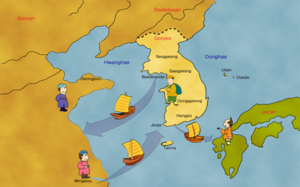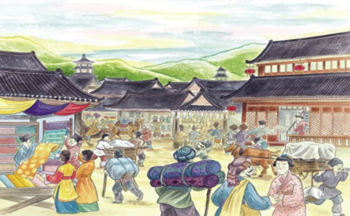2018 GGHS Team 9
목차
Management in Goryeo Dynasty, The stage of the Gaeseong merchant - Byeongnando
The Gaeseong merchant of the Goryeo Dynasty traded with different foreign countries through Byeongnando. It is also called 'Yeseong Port' and government officers were also hosted in the Byeongnando.[1]
2018 GGHS Team 9 Members
| Team Position | Name (English) | Name (Korean) | Student ID | Wiki ID |
|---|---|---|---|---|
| Teacher | Salma | 살마 | - | 9salma |
| Leader | Lee Shin Hee | 이신희 | 20205 | 9이신희 |
| Vice-Leader | Jeon Ji Hyeon | 전지현 | 20721 | 9전지현 |
| Member | Yang Ji Won | 양지원 | 20204 | 9양지원 |
| Member | Han Chae Rim | 한채림 | 20210 | 9한채림 |
| Member | Yoo Su Jeong | 유수정 | 20713 | 9유수정 |
| Member | Park Su Bin | 박수빈 | 10209 | 9박수빈 |
| Member | Kim Ga Eun | 김가은 | 10703 | 9김가은 |
| Member | Park So Hyun | 박소현 | 10709 | 9박소현 |
Management of the Gaeseong merchant in Goryeo Dynasty
During the Goryeo Dynasty, The trade was flourished by Gaeseong merchants beacuse of the frequent public and private trade with foreign merchantsas through 'Yeseonggang international port' that based in Byeongnando entrance.
Especially, ginseng was one of the highest traded product. Ginseng has cultivated in the Korean peninsula since the three Kingdoms era. During the unification of the later three Kingdoms, the ginseng that was grown on the Korean peninsula, was commonly called by Korean ginseng. In addition to that the Ginseng that was prdouced in Gaesong province has beacome famous since the middle of Goryeo period as it was the representative cultivation area of Korean ginseng.
Byeongnando
Byeongnando is an international trade port of East Asia in the Goryeo Dynasty that was located in the lower part of Yeosong River in Hwanghae Province. Originally, Song people called it "Yesung Hang" that was called before as the entrance of Yesung river,and it was frequently destinated place for trade by song merchants as well as japan and other merchants form south and west areas. Especially at that time, 'korea' was created by interacting with Arabian merchants. In addition to being international trade port, it was also the gateway to Goryeo, which must be visited to go abroad or enter the country. The importance of Byeongnando has been increased as it was designated as national road to Kaesong and according to the modification of the road network. Furthermore, being an international port increased the importance of Byeongnando. In addition, government officers were also hosted in the Byeongnando that was located in Byeongnando.
In Goryeo, mainly noble and royal goods were imported, it was written in the will that inherited from Goryeo, people made a great gathering and arrange all kinds of goods, especially they made a lot of effort to show the red and black silk in very impressive way. However, the plates that were made by gold and silver, were displayed only when the king came but the custom was not like that. Government or office's messengers were able to see these things, but not now. Mostly, the custom was that the people did not have shops only they went to the market in the midday where men and women, old people, and technicians as well traded by exchanging their own things without using money
Exports and Imports
Goryeo Exports
- Agricultural tools, grain, drape, stationery, gold, silver, najeon, hwamunseok, ginseng
Goryeo imports
- Jurchen imports - silver, fur, and horses
- Liao Dynasty imports - silver, fur, and horses
- Song Imports - silk, medicine, books, and porcelain
- Japan imports- pearl, Mercury, and sulfur
- Tamna Imports - Mercury, Flavor and Coral
Advantage of Location
Byrullando was the gateway to Gaegyeong, the capital of Goryeo. It was also a port on the estuary of the Ye Sung River, so it was easy to trade and it was connected also to the sea. Not only that but also the water was too deep to allow even the huge ships to get through.
Transportation was convenient as it is located between Song and japan. At that time, trading by sea route was widespread due to the Khitan and Jurchen. [4]
References
- ↑ Lee, Shin Hee. 2018. History of Goryeo.
- ↑ Korean National Culture Encyclopedia
- ↑ Encyclopedia of Korean culture, The Academy of Korean Studies
- ↑ Goryeo Dogyeong twenty-seven books




